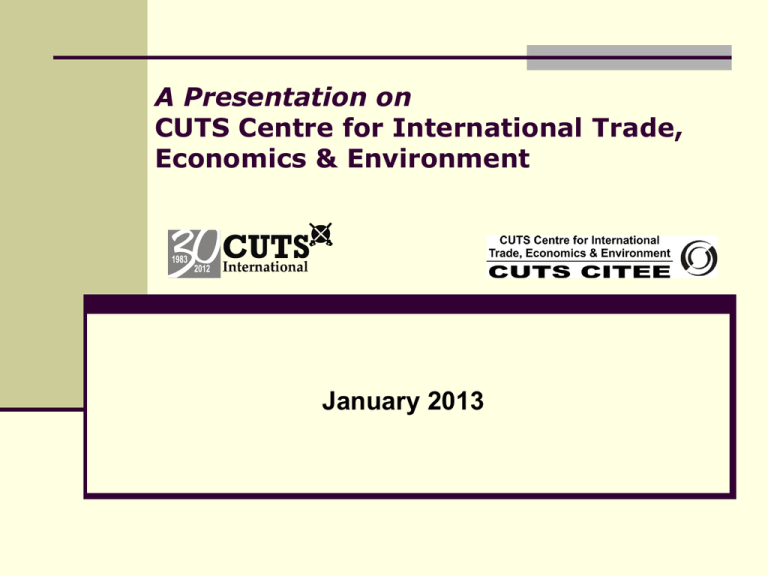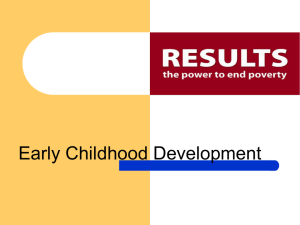Presentation - CUTS Centre for International Trade, Economics
advertisement

A Presentation on CUTS Centre for International Trade, Economics & Environment January 2013 Content A Brief History of CUTS An Overview of CUTS A Brief History of CUTS CITEE Some Major Achievements of CUTS CITEE Vision & Mission Goals Objectives SLOT Analysis Milestones Future Programme Future Strategy Human Resource Development/Management Financial Resources 2 A Brief History of CUTS In 1983, CUTS began its journey with a rural development communication initiative – a wall newspaper Gram Gadar (Village Revolution) A non-profit, non-governmental organisation with its headquarters in Jaipur, India, resource centres in Calcutta, Chittorgarh and New Delhi in India and four overseas centres: Geneva (Switzerland), Hanoi (Vietnam), Nairobi (Kenya) and Lusaka (Zambia) Evolved from litigation work on consumer protection to an internationally reputed policy action- and think-tank on interrelated areas of Governance, Trade & Development and Regulation 3 An Overview of CUTS CUTS Centre for Competition, Investment & Economic Regulation: To be a Centre of excellence on regulatory issues CUTS Centre for Consumer Action, Research & Training: To enable people, in particular women, to achieve their rights to basic needs and sustainable development through a strong consumer movement CUTS Centre for Human Development: To be an innovative Centre for strategic interventions to raise the living standards of people CUTS Safety Watch: To achieve for the citizens the right to be protected against unsafe goods, services and environment CUTS Institute for Regulation & Competition: Enhancing Knowledge, Strengthening Capacity 4 An Overview of CUTS Transparency and accountability – Value for People and Value for Money Marrying the cold of research with the hot of advocacy by extensive networking Emphasising on outcomes and not just outputs Fostering partnership for development: network-based policy research and advocacy in more than 30 countries in Asia and Africa, and in Geneva Linking grassroots with policy-makers and vice-versa A centrist approach and advocating for “Liberalisation Yes but with Safety Nets” 5 A Brief History of CUTS CITEE 1993: Involvement with trade and regulatory issues since early 90s when the Uruguay Round was at its peak – published a booklet titled “All About GATT – a consumers’ perspective” 1994: Compelling reason – not many consumer groups and other civil society organisations from the South were engaged in the UR debate – Co-convenor of Consumer International’s Global Policy and Campaigns Committee on Economic Issues 1995: Launched a civil society network: South Asia Watch on Trade, Economics & Environment – a demand-driven initiative One of the five founding members of Geneva-based International Centre for Trade and Sustainable Development 6 A Brief History of CUTS CITEE 1995-99 Emerging international trade regime under the aegis of the World Trade Organisation and bilateral/regional free trade agreements 2000-05 Developmental aspects of multilateral/bilateral/regional trade negotiations and their implementation 2006-12 Regional economic cooperation, linkages between trade, development and poverty and trade, climate change and food security, and larger issues of development cooperation – SouthSouth Cooperation (BRICS), South-North Cooperation (G-20), Trilateral Development Cooperation 7 Some Major Achievements of CUTS CITEE Working closely with several governments in Asia and Africa and in Geneva on trade and trade-related developmental issues Developed a vibrant network of civil society organisations and other stakeholders working on trade and development issues Served on various trade and trade-related committees of the Government of India and represented at the WTO Director-General’s Informal NGO Advisory Body and Stakeholders Panel on the Future of Trade Accredited to many inter-governmental and multilateral bodies such as WTO, UNCTAD, UNESCAP, UNDP, UNEP Received regular support from development cooperation partners and inter-governmental/multilateral bodies working on trade and development issues 8 Vision & Mission CUTS’ Vision Consumer sovereignty in the framework of social justice and economic equality, within and across borders CUTS CITEE’s Mission Pursuing economic equity and social justice within and across borders by persuading governments and empowering people 9 Goals of CUTS CITEE Enable and empower representatives of the civil society and governments, from developing countries in particular, to articulate and advocate on relevant and contemporary issues of trade and development at appropriate fora Create a questioning society through empowerment of civil society representatives to promote transparency and accountability in the system of trade governance Promote equity between and among the developed and developing countries through well-argued policy research and advocacy on emerging and relevant issues of trade and development 10 Applied/Action Research Objectives Present an independent political economic viewpoint on trade and trade-related economic, social and environmental issues from the perspective of Southern countries Sensitise policy-makers about trade and development issues confronted by the people at the grassroots Empower civil society and government representatives to understand issues of priority for better welfare of Southern countries Juxtapose counterfactuals in debates on trade and trade-related developmental issues on a scientific basis 11 Applied/Action Research Objectives Strengthen the capacity of developing country representatives in international trade negotiations and implementation of trade agreements Raise awareness in developed countries on trade and trade-related developmental issues for a better understanding of the concerns of Southern countries Assist representatives of inter-governmental/multilateral organisations to better understand trade and trade-related developmental issues from Southern perspectives 12 Advocacy, Networking & Capacity Building Objectives Convert policy research outputs to policy outcomes through evidence-based advocacy In partnership with research institutions and civil society organisations conduct action research on trade and trade-related economic, social and environmental issues, especially highlighting their Southern perspectives Exchange on regular basis information on programmes, activities and projects of mutual interest with a view to ensuring coordination, complementarity and mutually supportive cooperation and, where appropriate, joint action Cooperate and coordinate with like-minded organisations in conducting training and exchange programmes to enhance capacities and understanding of relevant actors on trade and trade-related developmental issues 13 Strengths Equal emphasis on ‘content’ as well as ‘process’ aspects of research, advocacy, networking and capacity building Timely delivery of quality outputs – a large number of research and advocacy outputs have been published and appreciated by a wide range of stakeholders Niche areas where a vacuum exists are identified and acted upon on a dynamic basis Wide networking and effective outreach: more than 60 network partners all over the world and targeted outreach to diverse stakeholders through two electronic platforms – CUTS Trade Forum and CUTS South Asia E-Group Targeted communication with trade policy-makers, trade negotiators and other stakeholder groups through publications and advocacy/networking efforts 14 Limitations Limited access to core support from development cooperation partners Organisational assessment by external agencies Evidence-based advocacy to achieve more and better policy outcomes Recruitment and retaining of good quality staff 15 Opportunities Expected emphasis on new and emerging issues coming under the ambit of multilateral/bilateral trade negotiations Enhanced scope of work on regional economic cooperation/integration in South and South East Asia and in Eastern and Southern Africa, and India’s deeper engagement with preferential trade agreements Increasing recognition of the role of trade in addressing developmental concerns such as linkages between trade, climate change and food security; trade, debt and finance; trade and technology transfer Increasing role of emerging economies in global economic governance – South-South cooperation, South-North cooperation, Trilateral Development Cooperation Scope to develop a multi-disciplinary human resource base located in different places 16 Threats Irregularities in continued support from development cooperation partners Effectiveness of policy advocacy efforts – co-option by stakeholder groups Continuation of senior level project managers 17 Milestones To become a core partner of development cooperation organisations in each programme area Recognition at national, regional and international level: representation at governmental, inter-governmental and non- governmental bodies presentation of outputs and results at major conferences to be approached by reputed organisations for partnership on specific projects Bridging macro-micro gaps in trade policy-making: to have at least 100 civil society organisations from South and South East Asia and Eastern and Southern Africa within its network and linking them with trade policy-makers and other stakeholders Implement at least 10 major, multi-year, multi-stakeholder, multi- country projects in next five years 18 Future Programme WTO Issues New and emerging issues in multilateral trade negotiations; development dimensions of the Doha Round of agreements to understand their implications in developing and least developed countries Regional Economic Cooperation Preferential trade agreements negotiated/implemented by India and regional economic cooperation/integration in South and South East Asia and Eastern and Southern Africa 19 Future Programme Developmental Issues Specific aspects of development such as linkages between trade, climate change and food security, trade, debt and finance, trade and technology transfer, trade-related aspects of gender, environmental and other socio-economic indicators, trade and other public policy objectives such as trade adjustment programmes, inclusive trade policy-making for balancing producer and consumer interests Cross-Cutting Issues including Capacity Building Enhancing the capacity of consumer and other groups in South and South East Asia and in Eastern and Southern Africa to better understand developmental implications of trade and trade-related issues, and enhancing the capacity of government officials and other relevant stakeholders on intricacies of commercial and economic diplomacy 20 Future Strategy Focused activities in South and South East Asia and in Eastern and Southern Africa in partnership with overseas centres of CUTS International Identification of new areas on trade and development issues where a vacuum exists by analysing their Political, Economic, Social and Technological implications More emphasis on network- and fieldwork-based action research so as to collect and analyse ground level evidence on trade and traderelated developmental issues Evidence-based advocacy targeting policy and practice changes – political-economic analyses of subject- and issue-specific policy environment to identify policy gaps and policy tasks and advocate for how policies are to be treated in future by strengthening the process of doing stakeholder and institutional mapping 21 Future Strategy Dynamic outreach to multiple stakeholder groups by organising discussions and debates on emerging and contemporary issues on trade and development – the subscriber base of CUTS Trade Forum and CUTS South Asia E-Group Reconstitution of the International Advisory Board with more emphasis on dynamically engaging them with the Centre’s activities Organisational assessment – at least one assessment during the next five years and in-house annual appraisal Project assessment – development cooperation partners to assess all major, long-term projects in respect to their Relevance, Effectiveness, Efficiency, Impact, and Sustainability, and in terms of their Value for Money 22 Future Strategy More emphasis on human resource development/management through in-house capacity building, especially on policy advocacy and networking and by team-building and retaining good quality staff, particularly at the managerial level, through monetary and non-monetary incentives Efforts to receive regular and long-term support from development cooperation partners including programme area wise core support 23 Human Resource Development/Management Objectives Accomplish delegation of work in a scientific manner and on the basis of motivating human resources to act as agents of change Build capacity through internal and external training Focus on team building and retention of good quality staff, particularly at managerial level At present, the composition of human resource capacity is as follows: Senior: 5 Middle: 6 Junior: 5 24 Human Resource Development/Management More emphasis on programme area wise team-building and their development, and gender and other dimensions of diversity in human resources A separate team for policy advocacy, networking and outreach, and capacity building Programme area wise consolidation of human resources and future staff composition: WTO Issues: 3 (Senior: 1, Middle: 1, Junior: 1) Regional Economic Cooperation: 25 (Senior: 6, Middle: 9, Junior: 10) Developmental Issues: 20 (Senior: 5, Middle: 7, Junior: 8) 25 Turnover (Rs. Million) Financial Resources 26







